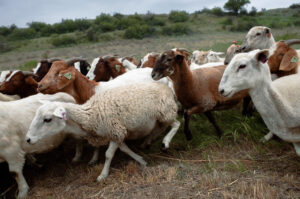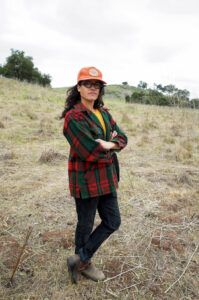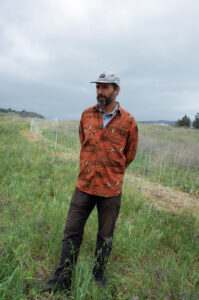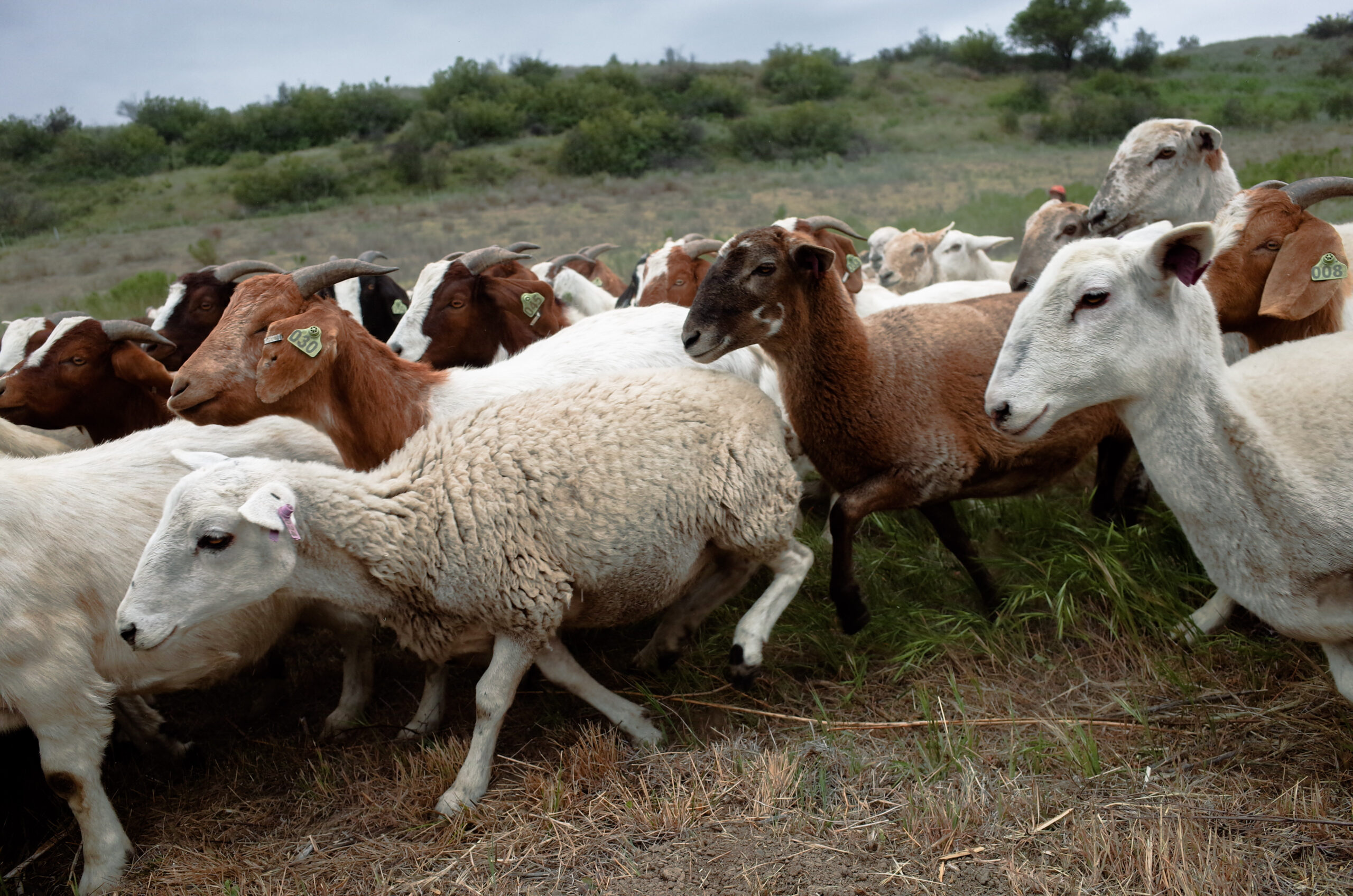FEATURE | By Love Nguyen
The Shepherd’s Quest

Goats are an important tool in weed abatement and hence fire safety.
Brittany Cole Bush, known to most as Cole, has acquired 250 goats and sheep and keeps them on a long lease ranch in Upper Ojai. Her intentions are to help manage the lands in the Ojai Valley and Ventura County, by using grazing animals, instead of spraying Roundup or directing those noisy weed whackers.
Her company, Shepherdess Land and Livestock Company, has already hit the ground running this spring, with clients like Besant Hill School to help restore the lands and the native plants to come back by using graze-and-trample methods that open up the dirt to seeds in the ground and to let in more moisture. She’s also been busy securing private clients who want to graze for fire prevention.
Fire abatement and preserving the natural ecosystem have been top priority for many residents of the Ojai Valley. Now, they have another ally in Cole and her company, who can help tend to our lands sustainably.
Trevor Warmedahl is one of her seasonal employees. When she’s out doing due diligence with clients, he tends to the flock, moving the electric fence and instructing the sheep dogs and their Mongolian guard dog, Bok. He’s a hardcore pastoral nomad who can be found where the animals are, 24-7, pitching a trailer on the properties where the flocks are grazing.
This interview took place in the spring, so puppies and kits abound, as Cole and her lean company are busy managing Ojai lands preparing for another harsh summer, as climate change brings more fire hazards and water evaporation.
So, what is your background? How did you come to being a shepherdess or shepherd?
Cole: My family had a business, and every weekend we would go south of the border to visit the factory and be with all of the workers’ families in Mexico. We shared food together and as a kid, I questioned why it was so much more fun and vibrant to celebrate with their tight-knit communities than growing up in a suburb like Torrey Pines, California, where we didn’t even know our neighbors. It felt disconnected.
 I kept asking myself, where are the happiest people in the world and where is the meaning in my life? How do I celebrate culture and stay connected in our rapidly developing world?
I kept asking myself, where are the happiest people in the world and where is the meaning in my life? How do I celebrate culture and stay connected in our rapidly developing world?
This constant inquiry led me to understand that food brings people together. I looked at ancient civilizations and how they built their environments within nature, like earthworks to terrace and canal for moving water, for their intense farming. I took time off before college and traveled to Tanzania to be with the Masai in Kilimanjaro. I saw this Masai shepherd with a goat when I was like 19 or 20 years old, and the seed was planted. I ended up studying agroecology and environmental studies at UC Santa Cruz while living on this farm, Encyclopedia Pictura (the same studio which animated Bjørk as a shepherdess on a yak for “Wanderlust’) in Trout Gulch.
We adopted two dairy goats and befriended the manager of Star Creek Ranch. Her herding dog really took to me, so I ended up adopting her. It was through the dog that I started working at Star Creek after she left and helped them start “Star Creek Land Stewards” which was the first grazing business in the Bay Area.
We worked with East Bay Regional Parks District, the second largest in the country, and they’d been hiring goats for contract grazing for over two decades since their big fires in the ‘80s. I talked my friend’s dad who managed there, into going after contracts to help graze for fire prevention.
When I was 25 years old, I managed multi-year contracts with revenues of up to $300,000 annually, using goats from Star Creek to graze up to a 1,000 acres per contract. That’s how I got my start.
We expanded from the Bay Area over to Marin County. I left that to go into education and advocacy, consulting for farms. My next big inquiry was, “How can we get more people to do this?” I was into this notion of “ancient futures” managing animals by looking at how people herded in the past and to use our updated technologies. They say that shepherding is the second oldest occupation.
Right, Jesus’s dad was a shepherd! People live closer to animals in the countryside and they still do in second-world countries. In most cities and towns, we are completely removed from animals since the industrial revolution and factory farming in the U.S. took over.
Cole: What we’re learning is that when you remove part of the natural system, the system breaks. So, we want to go back. Animals do best when they are in a herd. They’re supposed to move. That’s the nature of these animals. They’re social.
You and Trevor have different backgrounds and experiences that really complement each other.
Trevor: I’m from Washington State, originally. When I was a kid, I wanted to be an explorer or a mountain man but people were like, “That’s not really a profession anymore.” I came to shepherding through food. I loved cooking and worked in restaurants from when I was 18 to 26. I got interested in fermentation and started making bread and then cheeses at a pizzeria.
You made fresh mozzarella for a pizzeria? That’s kinda rad and rare.
 Trevor: Yeah. Then, I got my first cheesemaking job and was making cheese from milk that somehow got to me in downtown
Trevor: Yeah. Then, I got my first cheesemaking job and was making cheese from milk that somehow got to me in downtown
Seattle, and I was like, “This doesn’t make sense.” I never saw the cow.
Hmm, you were like, salt, rennet, repeat?
Trevor: Basically. The idea of raw milk appealed to me, so I got a job on a farm in Monterey, California on a sheep ranch when I was 26. I fell in love with cheesemaking and got into animal husbandry through that. I also loved the idea of participating in a local economy and living on this land that we were stewarding. The land was actively regenerated from a commercial strawberry farm back to its native grasses by grazing. I saw a link where you could make food, have a positive impact on the land and produce a local economy. I got into doing the farmhand stuff for about ten years.
I went to Mongolia two years ago to consult on how to make American cheeses and managed this plant, but then that didn’t make sense to me.
I wanted to see how the locals were producing their cheeses from yaks and check out the herding culture. So, I quit my job and saw people herding massive amounts of animals without fences.
Sounds like you’re getting closer and closer to the source and unlearning.
Trevor: Totally. As I’m shifting my paradigm for how cheeses are made closer to the source, it’s challenging my paradigm on animal husbandry and livestock. Natural cheesemaking and herding provides me with perspectives on ways humans, animals and landscapes can interact. In America, we’re really profit-driven, so we’ve manipulated the animals genetically but it doesn’t work. It’s just more expensive and the output isn’t actually more. We really don’t need to bring all this stuff to them, to put them on a diet or genetically modify anything. You can have them on a landscape and lead them to food.
The dogs are key to shepherding in America and Europe, right?
Cole: Yes, that Star Creek dog I mentioned is the grandma to my dogs now. They are absolutely the key; the livestock guardian dogs protect the herd from predators and the border collies shepherd where they need to go. The guardians are originally from Mongolia via Wyoming.
Trevor: Yeah, these animals are like family to me. In Mongolia, they weren’t using fences or dogs. They just had a better understanding of the animals and their psychology. Basically, they trusted the animals more. There were families that lived interspersed on the land watching over these herds. It made me reevaluate the systems that I had learned in America.
I love that they pay attention to the animal behaviors rather than trying to control them.
What brought you to Ojai?
Trevor: When I came back to the U.S., (from Mongolia), I was like, “How can I be a herder, here?” Last year, I was working at a holistically managed dairy farm in Vermont, and the wildfires were happening in California. I saw it as an opportunity to get involved with fire reduction grazing. I admire pastoral nomading especially in the modern context. It’s adaptive. We’re going to impact the land one way or another. It’s either going to be positive or negative.
Cole: I fell in love with Ojai after a yearly pilgrimage to drop off my San Francisco roommates who grew up here. I fell in love with the valley and love brought me back. I moved to Ojai officially right before the pandemic to move in with my partner Clare, and manifest this dream business!
Talk to me about “prescriptive grazing,” as a lot of clients are particular about keeping the natives and weeding out the invasives.
Cole: A lot of invasives and annual grasses choke out some of the desired, perennial grasses which grow deeper and cycle water and minerals through. If we graze the annuals when they try and compete for resources then we can encourage the natives. It’s all in the timing.
Trevor: To me, they’re all the same. I mean, they’re plants living on the land. They’re here.
I do question, at what point does an invasive become native, if they’ve been here for decades or longer? Also, most weeds are medicinal. I’ve learned from herbalists that weeds actually grow in response to humans’ needs for healing. I spent last spring weeding milk thistle on a friend’s property, and all that stuff was really good for my thyroid recalibration.
Trevor: Exactly.
You don’t just do fire abatement work with the animals. You have ecological goals even if that’s a bi-product of grazing.
Cole: All our projects have ecological goals. At Besant Hill, we’re doing this vernal pool restoration. The land has been untended for a while, so we’re trying to restore it back to its marsh-like properties. So, all this thatch (pointing and stomping over it), needs to be broken up so that the soil can get sun and moisture as a fertile seed bank. The ungulates trample it to encourage that. It’s called “animal impact.” Managed properly, animals can be really beneficial to the land. We want to take all the mustard out to enhance and increase our watershed. Grazing can be controversial, but as long as it’s strategic, it can be really healthy for restoration.
Tell me about some of your collaborations that are in motion in the Ojai Valley?
Cole: The Ojai Valley Fire Safe Council 2021 is developing a Community Supported Grazing Program (CSGP). The CSGP is a multi-stakeholder approach, with public and private landowners and managers, to create a singular source of funding and management oversight for contract grazing services. They want to increase targeted grazing by sheep and goats for vegetation management and ecosystem enhancement projects in the Ojai Valley. It’s an approach that is both a practical and impactful, ecological alternative to using chemicals and fossil fuel-dependent mechanical methods. This program will engage the community by grazing in some of Ojai’s most populated areas, bolstering participation efforts to increase the Valley’s fire resilience. We want to create a grassroots model for other counties. We’re learning that we are stronger in collaboration and not competition.
What are some of the biggest challenges you face?
Cole: A lot of people have lost their connection to animals and how they are beneficial to land stewardship. Some don’t understand how hard it is to do this as there aren’t a lot of modern shepherds. It’s also tricky to start an agriculture business without a lot of money.
Trevor: The stakes are high. There’s been some animal deaths. I mean, that can be really hard. They’re living beings and it’s a big responsibility. The challenge is also the opportunity and its reward. Also, the heat is coming, it’s an isolated life… someone has to be 20 minutes away from the animals at all times.
This herd, I imagine, is like your family. It’s a mind shift that animals, including humans, are part of an ecosystem. Would you ever apply some of that nomadic technology that you learned without fences in Mongolia, here? Cole and I talked about her trips to the Basque area and the importance of sharing information.
Trevor: We’ve been trying it out on our ranch, “circuit grazing.” It’s cool because done strategically, you can form trails and flocks can break up dead trees. They totally go for all those old Oaks first and can help prune the low parts to encourage them to grow upwards. Commercially, we’re so close to other people’s property lines here, though. So, we have to be aware of that.
What’s the dream?
Cole: A queer woman, from the suburbs, first-generation shepherdess can achieve success in this business. I want to impact as many acres and lives as possible. I want to create viable jobs that are rewarding.
Trevor: I want to be a modern herder. I saw this resilience in Mongolian nomadic culture where they move and can adapt. We can see how fragile lands are and you can’t adapt as well if you’re in one place defending that land. I’ve always moved around a lot.
I really admire the pastoral nomads. They know all the plants with encyclopedic knowledge that goes back generations and have an intimate relationship with ecosystems. It’s a beautiful thing. It gives you a different way of looking at the land, being immersed. Being with animals and moving from different plant communities, I love shepherding as it’s a constant interaction with the cycles of nature and being part of a herd. It’s a beautiful thing to have work that’s aligned with my values. Can’t beat that.
Ultimately, I am looking for ways to combine this ecological, impact focused-grazing with dairying. I want to make cheese on a very small scale and have the animals on a wild feeding program to eat indigenous plant communities, not pastured monocultures. Just releasing control and having them eat a diversity of plants which is how it’s done in a lot of other countries. The priority is the animal and land health, not how much product I can make in a year.
People seem stoked on you guys, the goats and sheep so far. Inherently, people are drawn to these peaceful animals. I wish you luck in honoring them and the lands you touch.
Trevor: Yeah, I mean people are enthusiastic and it’s a cool way to introduce this idea of pastoralism. I see it as an opportunity to see what’s capable when you introduce animals back onto your land: you’re fertilizing in place; you’re cycling vegetation through the animals and trying to shift the land and its plant communities; reopening up the dirt with their hooves to hold grey water. After the fires, if your house is threatened, you start to open up to new paradigms. If you don’t tend to the land, you can have cataclysmic burns. Multiple strategies like strategic burning, grazing and what’s appropriate where and when for your site is a conversation. Going back to how humans are inevitably here and impacting positively.


Leave A Comment